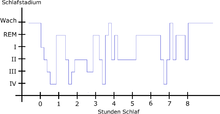REM sleep
As REM sleep (from English rapid eye movement , 'rapid eye movement), and paradoxical sleep or desynchronized sleep called a is sleeping referred phase, inter alia, by rapid eye movements with closed lids is characterized, accompanied by a reduced tonus of skeletal muscle ( see also sleep paralysis ) and a specific activation pattern in the EEG - theta waves with a frequency of 4 to 8 Hz and slow alpha waves . In addition, there is a lively beta activity that is normally only found in the waking state. During REM sleep, blood pressure and pulse rise again, while they are reduced in non-REM sleep phases.
REM sleep was discovered in 1953 by Eugene Aserinsky and his professor Nathaniel Kleitman at the University of Chicago .
Occurrence and duration

In adults, REM sleep takes up about 20 to 25% of sleep. With a sleep duration of 7 to 8 hours this is about 2 hours. Little time is spent in REM sleep at the beginning of the night, and the frequency and extent increase towards the end of the night.
Until around the age of eight, the time of the REM phase is reduced from nine hours (after birth) to around three hours. After that there are no major changes in the duration of this phase.
Side effects
Most dreams take place in this phase , dreams occur less often during non-REM sleep (also known as NREM sleep ).
A correlation was suspected early on between the eye movements observed during the REM phase and a dream happening at the same time. An experimental verification of this so-called scanning hypothesis was achieved in 1999 in a study in which sleeping test subjects voluntarily moved their eyeballs during a lucid dream phase according to a previously agreed movement pattern.
In this sleep phase, in addition to dreams , nocturnal erections also occur, and the procedural memory is more likely to be built up .
function
There are many hypotheses about the function of REM sleep, some contradicting one another. The fact is that in the nights following a withdrawal of REM sleep, the REM phases occur more frequently, in the sense of catching up. With persistent REM sleep deprivation, many test subjects show, in addition to learning and concentration difficulties and memory problems, increased drive-like behavior with increased feelings of hunger and increased sexual and aggressive impulses, while others also tolerate longer and almost complete withdrawal of REM sleep well. The fact that rats can die after two to three weeks of complete REM sleep deprivation initially only shows that the results from animal experiments often cannot be transferred one-to-one to humans. The REM sleep phase could be observed in all mammals examined so far with the exception of the dolphin and the Echidna .
Presumably, the learning process is generally closely linked to REM sleep. Tasks in drive regulation , information processing and stress management are discussed.
Many test subjects with REM sleep deprivation have particular difficulties, especially when faced with complex and new challenges - a fact that plays a major role in everyday life, especially for old people. The clinical importance of sleep disorders and their treatment, especially in old age, is thus underlined - on the other hand, the uncritical administration of sleeping pills is also criticized because they suppress precisely those brain wave activities that dominate in REM sleep.
REM sleep behavior disorder
Failure to decrease muscle tone during REM sleep can lead to the motoric acting out of dreams, whereby those affected can also fall out of bed, kick around or stand up and run around aimlessly or scream. This behavior disorder mainly affects men with a mean age of onset of 60 years.
REM latency - sleep onset REM
REM latency is the time between falling asleep and the beginning of the first REM phase. For most adults this is around 90 minutes (± 30 minutes). If the REM latency is greatly reduced, it is referred to as premature REM sleep (sleep onset REM or SOREM).
This phenomenon is associated with sleep disorders, such as narcolepsy , but also occurs in sleepless people who are sleep deprived .
See also
literature
- NR Carlson: Physiological Psychology. Pearson Studium, Munich 2004, ISBN 3-8273-7087-6 .
Web links
- Alexander Borbély: The Secret of Sleep. University of Zurich, 1998.
- PBS series “NOVA” 39th season, episode 12: “What Are Dreams?” WGBH Educational Foundation, Boston, November 20, 2009.
Individual evidence
- ↑ Jayne Gackenbach, Jane Bosveld: Ruler in the realm of dreams. Creative problem solving through lucid dreaming. Aurum, Freiburg im Breisgau 1991, ISBN 3-591-08298-8 , p. 215 f.
- ^ S. LaBerge, P Zimbardo: Smooth Tracking Eye-Movements Discriminate Both Dreaming And Perception From Imagination. Abstract of talk presented at the Toward a Science of Consciousness Conference IV, Tucson, April 10, 2000.
- ↑ Michael H. Wiegand: Sleep and Dream. Schattauer Verlag, 2006, ISBN 3-7945-2386-5 , p. 89 ( limited preview in the Google book search).
- ^ A b Johannes Schwarz, Alexander Storch: Parkinson Syndrome. W. Kohlhammer Verlag, 2007, ISBN 978-3-17-018382-7 , p. 156 ( limited preview in Google book search).
- ↑ S. Noachtar, I. Very iron: REM sleep behavior disorder. In: The neurologist. Volume 71, 2000, pp. 802-806. quoted in Johannes Schwarz, Alexander Storch: Parkinson-Syndrome. W. Kohlhammer Verlag, 2007, ISBN 978-3-17-018382-7 , p. 156 ( limited preview in Google book search).